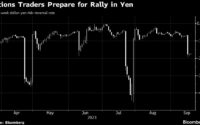Fed Economists Warn Large Economic Shockwave Likely, With ‘High Share’ of Companies Now in Financial Distress
The Federal Reserve just issued a fresh warning on the state of the US economy.
A research note published by two Federal Reserve economists says the number of non-financial firms that are now in financial distress is at historic levels.
“The stance of U.S. monetary policy has tightened significantly starting in March 2022. At the same time, the share of non-financial firms in financial distress has reached a level that is higher than during most previous tightening episodes since the 1970s.”
The number of distressed firms now stands at 37%.
And the Fed economists conclude that their math suggests the true impact of the Federal Reserve’s sharp interest rate hikes may be looming and large.
“Do our results suggest that the monetary policy tightening engineered since 2022 might have substantial effects on investment and employment given the high share of firms currently in distress relative to previous tightening cycles? While answering this question is difficult, back of the envelope calculations indicate that the effects may be large.
To start with, total investment in our sample of publicly-listed firms accounts for about 60% of aggregate U.S. investment and aggregate investment is one of the most responsive components of GDP to monetary shocks.
There is also evidence that employment for Compustat firms accounts for around one-third of total U.S. non-government employment… With the share of distressed firms currently standing at around 37%, our estimates suggest that the recent policy tightening is likely to have effects on investment, employment, and aggregate activity that are stronger than in most tightening episodes…
The effects in our analysis peak around one or two years after the shock, suggesting that these effects might be most noticeable in 2023 and 2024.”
The Fed warns its own policies may push those distressed companies closer to default, and their failure could in turn trigger a wave of previously unforeseen layoffs.
“Our analysis may underestimate the true effects on employment because policy tightenings might push some distressed firms closer to default and contribute to a wave of bankruptcies with associated layoffs.
Layoffs caused by firm bankruptcies would not be captured by our data and, for this reason, our estimates on the effects on employment could be considered a lower bound of the magnitude of those effects.”
Don’t Miss a Beat – Subscribe to get email alerts delivered directly to your inbox
Check Price Action
Follow us on Twitter, Facebook and Telegram
Surf The Daily Hodl Mix
 

Disclaimer: Opinions expressed at The Daily Hodl are not investment advice. Investors should do their due diligence before making any high-risk investments in Bitcoin, cryptocurrency or digital assets. Please be advised that your transfers and trades are at your own risk, and any loses you may incur are your responsibility. The Daily Hodl does not recommend the buying or selling of any cryptocurrencies or digital assets, nor is The Daily Hodl an investment advisor. Please note that The Daily Hodl participates in affiliate marketing.
Generated Image: Midjourney
[ad_2]
Source link


